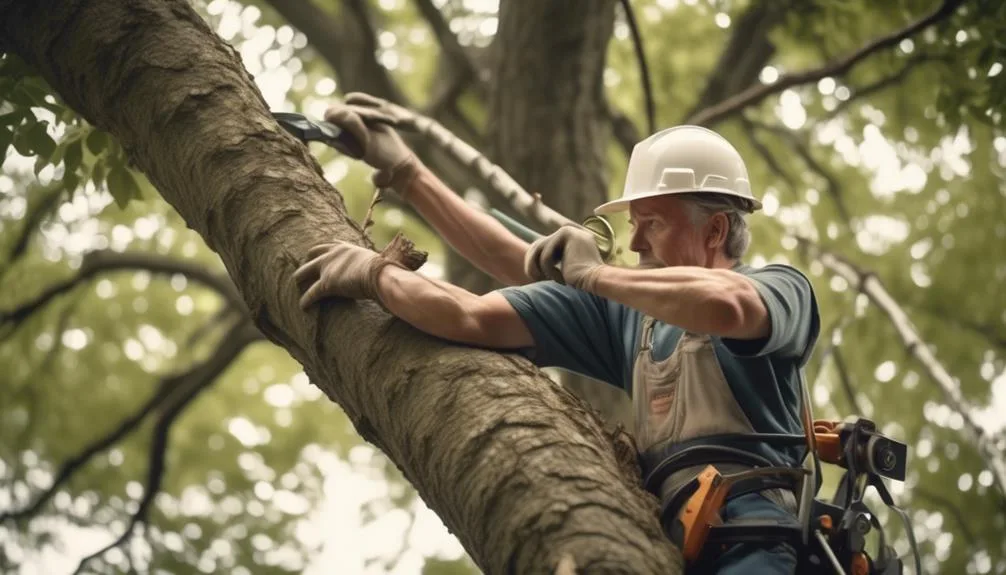Can Hickory Trees Be Shaped and Trained
Are you curious about shaping and training your hickory tree? Picture it like sculpting a living masterpiece in your yard. There are techniques and challenges to consider in molding its growth. Whether you want to enhance its beauty or manage its size, there are methods to help you achieve your goals.
Let's explore the possibilities and rewards of shaping and training hickory trees.
Pruning and Shaping Hickory Trees
To maintain the health and shape of your hickory trees, regular pruning is essential. Hickory trees have a unique growth pattern, with their branches reaching out at wide angles and their canopies spreading wide.
When pruning hickory trees, it's important to understand their growth patterns and choose the right techniques. Start by removing dead or diseased branches to promote overall tree health.
Then, focus on shaping the tree by selectively pruning to encourage upward or lateral growth, depending on your desired outcome. Proper pruning techniques can help maintain a strong and attractive structure, prevent overcrowding, and improve air circulation and sunlight exposure.
Training Young Hickory Trees
When shaping and training young hickory trees, it's crucial to understand their growth patterns and apply appropriate techniques to encourage healthy development and desirable structure. Hickory trees tend to have a strong central leader with lateral branches that grow in a spiral pattern around the trunk.
To effectively train young hickory trees, consider the following:
- Pruning: Remove any competing leaders and poorly positioned branches to maintain a dominant central leader.
- Staking: Use stakes to support the young tree and promote an upright growth habit.
- Training branches: Utilize gentle bending and tying techniques to encourage lateral branches to grow outward, creating a balanced canopy.
Understanding these tree shaping techniques and hickory tree growth patterns will help you guide the young hickory tree's development for long-term health and structural integrity.
Shaping Mature Hickory Trees
Mature hickory trees can be shaped and maintained through strategic pruning and support to ensure their continued growth and structural integrity. When shaping mature hickory trees, it's essential to use proper techniques to maintain their natural tree architecture.
Begin by identifying any overgrown or crossing branches that may hinder the tree's overall form and carefully prune them to promote healthy growth. Additionally, consider using support structures such as braces or cables to reinforce weak or heavy branches, preventing potential damage.
Considerations for Hickory Tree Shaping
Consider shaping Hickory trees by strategically pruning and providing support to ensure their healthy growth and structural integrity. When considering shaping a Hickory tree, it's crucial to understand the specific considerations to ensure successful shaping techniques and overcome potential challenges.
Here are some key factors to keep in mind:
- Hickory Tree Growth: Understanding the growth patterns of Hickory trees is essential for effective shaping. Consider the tree's natural tendency to develop strong, upright branches and how it responds to pruning.
- Shaping Techniques: Explore various methods for shaping Hickory trees, such as directional pruning and branch training, to achieve the desired structure while promoting healthy growth.
- Tree Shaping Challenges: Be aware of potential challenges, including the tree's slow growth rate and its susceptibility to damage during shaping, and develop strategies to address them effectively.
Maintaining Shaped Hickory Trees
To maintain the shaped and healthy growth of your Hickory trees, regular pruning and monitoring for potential issues are essential.
Understanding the growth patterns of Hickory trees is crucial for effective maintenance. Hickory trees generally have a strong central leader and upward-reaching branches. As part of maintenance techniques, it's important to continue shaping the tree as it grows, promoting a balanced and open canopy.
Regular pruning is necessary to remove dead, diseased, or crossed branches, maintaining the tree's health and shape. It's also essential to monitor for signs of pests, diseases, or structural issues and address them promptly.
Conclusion
With proper pruning and training, hickory trees can be shaped to complement your landscape. By understanding their specific needs and maintaining their shape as they grow, you can enjoy beautifully shaped hickory trees in your yard for years to come.
How will you shape your hickory tree to enhance your outdoor space?
Mark Hoffman is a dedicated arborist and tree care specialist with over a decade of experience. His love for trees began when he visited Yosemite National Park as a teenager and was awestruck by the giant sequoias. Mark pursued his passion by studying forestry at Michigan Technological University, where he earned a Bachelor of Science degree.
Since then, he has worked tirelessly in the field of arboriculture, helping to preserve and protect trees in his community. His expertise and dedication have made him a respected leader in the industry and a valuable resource for anyone seeking advice on tree care.
